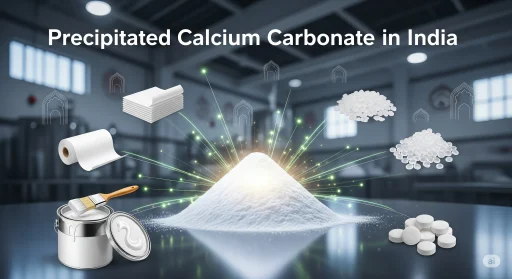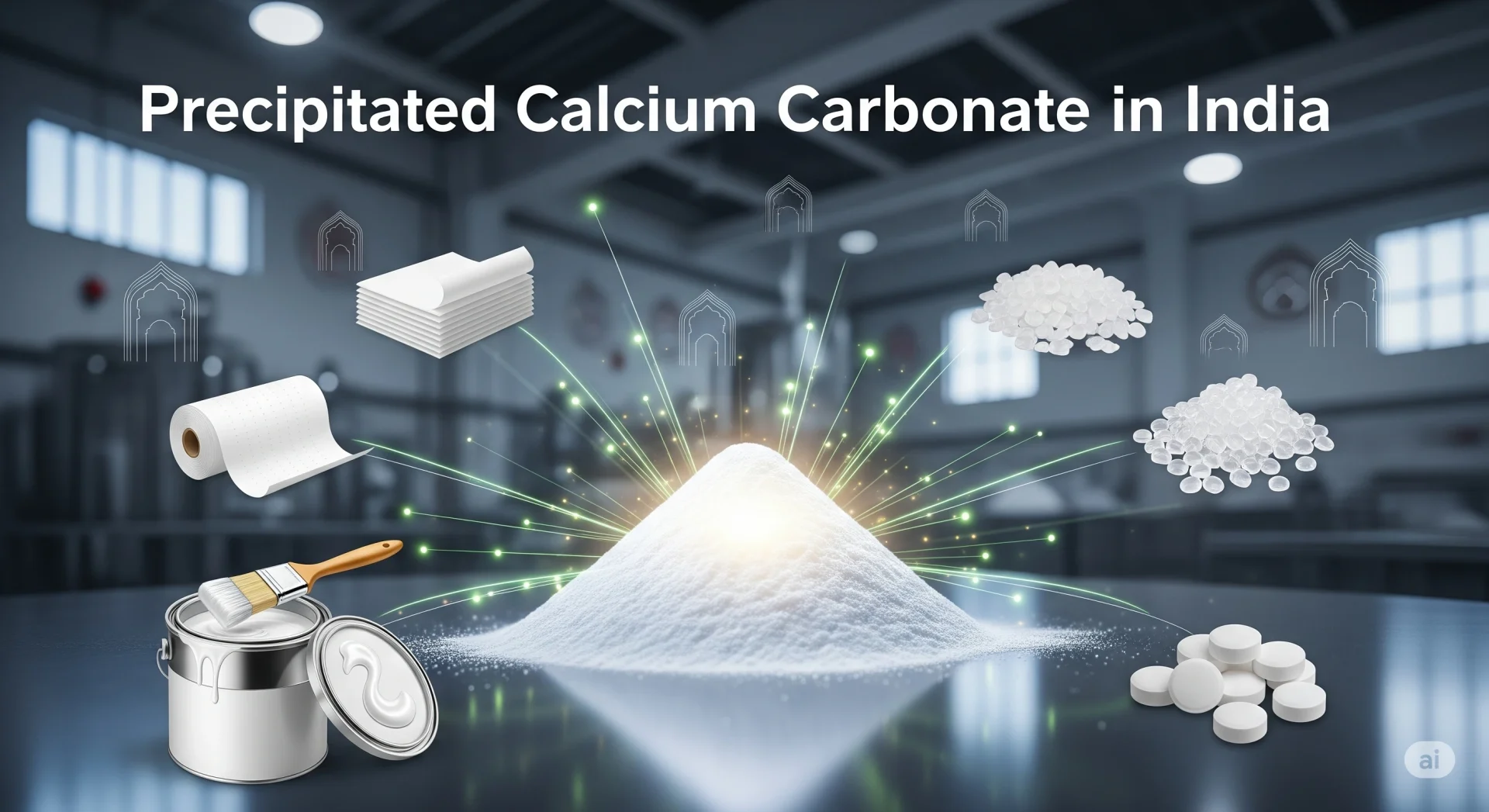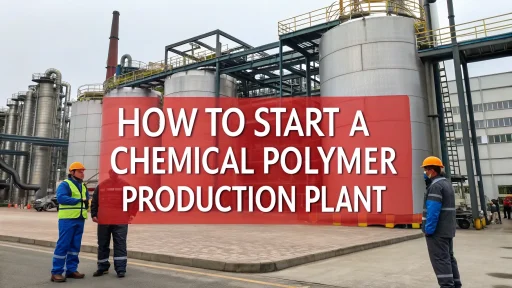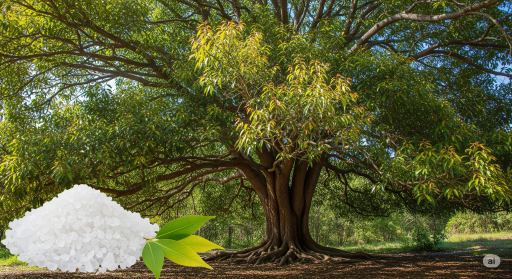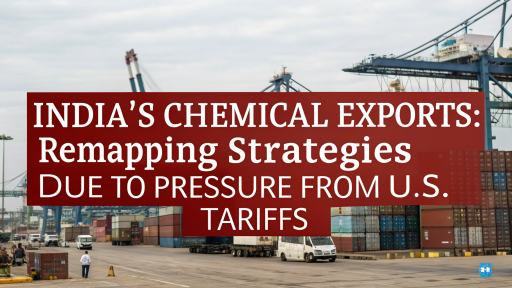You can find a wide variety of products all around you. From the smoothness and vibrant colors of paints, to the ingredients that are essential in pharmaceuticals, and the reinforcing agents in plastics. precipitated Calcium Carbonate (PCC), is likely to play a vital, but often invisible role in the creation of these products. PCC is an essential industrial mineral in India, which has a growing manufacturing sector and a fast-growing economy.
Precipitated Calcium Carbonate isn’t just crushed limestone or chalk. People make it through a controlled chemical process in a lab. They use this method to get a pure form of calcium carbonate (that’s CaCO₃). By controlling production, they adjust things like particle size, shape, and surface area. This way, they can create exactly what different industries need. PCC is superior to its natural counterparts in terms of brightness, uniformity and whiteness. It’s the first choice for many high-performance applications.
This article is a comprehensive look at precipitated calcium carbonate and its applications in India. We will examine its unique manufacturing process and its various grades and forms, as well as its wide range of applications in key Indian industries. We will also explore the factors driving its demand, key players on the Indian market and environmental concerns associated with its use and production. Understanding PCC will help you understand the manufacturing landscape in India and the materials that are driving its growth.
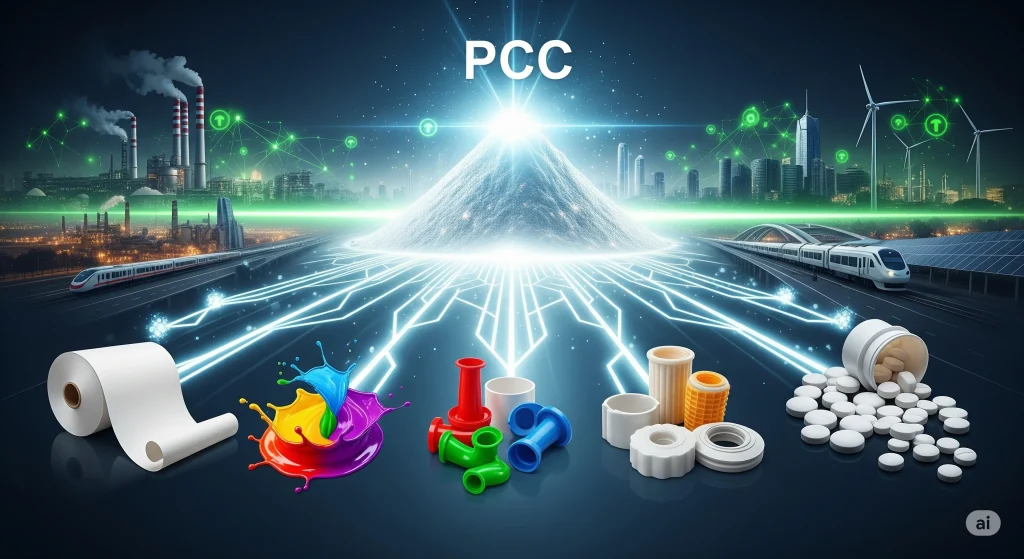
Understanding the Science of Manufacturing Process
Precipitated calcium carbonate production is a complex chemical process with several steps that allow for precise control of the product’s properties. The process is the most common, and involves the following steps:
Raw Material Preparation
The main raw material for the production of alumina is high-quality calcium carbonate (limestone). The limestone is crushed, then heated to high temperatures in a kiln. This process removes carbon dioxide (CO2), resulting in quicklime (calcium Oxide, CaO).
CaCO3 (limestone) + Heat – CaO (quicklime) + CO2 (carbon dioxide)
They capture the carbon dioxide when they heat up the materials during calcination. Later, they use that CO2 instead of releasing it into the air. This makes the process more sustainable.
Slaking
This exothermic process produces calcium hydroxide, or Ca(OH)2, also known as slaked limestone or milk of lime.
CaO (quicklime), H2O (water), Ca(OH2)2 (slaked limestone) + heat
Slaked lime usually comes in the form a slurry, which is a mixture of liquid and solid particles.
Read More: Calcium Carbonate Production
Carbonation
Carbonation is the key reaction in PCC manufacturing. They grab carbon dioxide, whether it’s from burning limestone or some other source, and bubble it into a calcium hydroxide solution. They control the whole process to make sure everything reacts right. These include temperature, pressure and rate of CO2 adding. The reaction results in fine calcium carbonate particles precipitating.
Ca(OH)2 (slaked lime) + CO2 (carbon dioxide) – CaCO3 (precipitated calcium carbonate) + H2O (water)
The PCC can be tailored to suit the needs of the manufacturer by precisely controlling the reaction parameters.
- Particle size: From nanometers to millimeters. Influences properties such as opacity and gloss.
- Particle shape (Morphology). Different crystal shapes can be produced such as calcite, aragonite or vaterite.
- Surface area: Affecting PCC’s performance and interaction with other materials.
Filtration and washing
You filter out the water once the PCC has the right properties. Then you wash the solid PCC in water to get rid of any impurities or leftovers.
Drying
After washing, you dry the wet PCC. Some people use flash drying, others go with spray drying—depends on what works best.
Read More: Start Potassium Hydroxide Business With low Investment
Milling and classification (Optional )
If you need finer particles, you mill the dried PCC. Finally, you use classification methods to make sure the particle size is uniform.
Surface Treatment (Optional)
The surface of PCC particles are treated with organic and inorganic agents. These surface treatments may improve dispersibility (in polymers and paints) or adhesion in various matrices.
The Grades of PCC: A Spectrum of Properties
PCC is versatile because it can be produced in different grades, each with their own unique properties. Some of the most common types are:
- Calcite (PCC): Most common and stable crystal form. Used in paints, adhesives, plastics and paper. Calcite can have different morphologies, such as rhombohedral and scalenohedral.
- Aragonite Pcc: Characterized with its needle-like structure or prismatic structure. It offers high reinforcing qualities, making it ideal for certain polymer applications and rubber applications.
- Fatherite PCC A metastable, spherical shape with a high surface area. It finds niche applications in pharmaceuticals.
- Precipitated PCC vs. Ground PCC: The difference is important to note. GCC is natural limestone that has been mechanically ground, whereas PCC is a chemically synthesized product. PCC offers a higher purity and better whiteness, as well as a controlled particle size.
Read Our Project Report: Click Here
Diverse applications of fueling Indian industries
PCC is a unique ingredient that has become indispensable in India’s wide variety of industries.
- Paper industry: In the papermaking process, PCC is widely used as a coating pigment and filler. It can improve paper brightness, opacity and smoothness. It is often used to replace more expensive materials such as titanium dioxide. This allows the production of alkaline papers, which have a longer lifespan than acidic paper.
- Paints & Coatings: The PCC is used as a functional filler, extender, and extender in paints, inks, and coatings. It increases opacity and whiteness of the product, as well as brightness, scrub-resistance, and durability. It can reduce costs without compromising on performance.
- Plastics & Polymers: The PCC filler is used in a variety of plastic and rubber products. It increases tensile, impact, stiffness and dimensional stability. It is also a cost-effective extension. PVC profiles and pipes, automotive parts and packaging films as well as rubber goods are all possible applications.
- Adhesives & Sealants: The PCC can improve the strength of adhesives & sealants and reduce shrinkage when curing.
- Pharmaceutics: PCC high-purity goes into tablets and capsules as an excipient. It acts as a binder, fills space as a diluent, and even works to reduce stomach acid. Researchers are now testing nano-sized PCC for drug delivery.
- Food industry: PCC food-grade is used in fortified beverages and foods as a calcium source. It can be used as a color-retention agent, an anti-caking and an antiseptic.
- Construction Industry: GCC grades usually go into cement, concrete, and tile adhesives. People use PCC when they want to boost performance in certain construction products. It’s less common, but it gives those materials an upgrade when needed.
- Agriculture: Finely grounded PCC can act as a soil amendent to neutralize acidity, and to provide calcium to the plants.
- Cosmetics PCC is used in cosmetic formulations to act as an opacifying or filler.
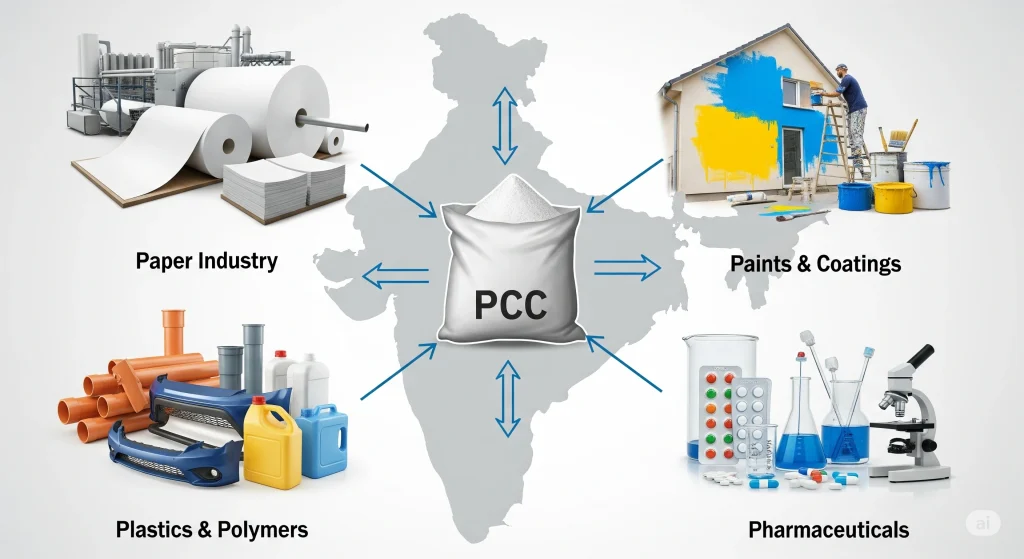
The Indian Market: Key Players and Growth Drivers
In recent years, the Indian market for precipitated Calcium Carbonate has seen significant growth. This is due to several factors.
- Strong growth in end-use industries: In India, the expansion of the paper and paints and coatings sectors, as well as the plastics and pharmaceuticals sectors, directly drives the demand for PCC.
- Growing Awareness of Performance and Quality: Manufacturers increasingly recognize the superior properties and benefits offered by PCC in comparison to traditional fillers such as GCC.
- Demand for High-Quality Product: Consumer awareness is growing and the demand for higher quality products in various sectors is pushing manufacturers to use PCC.
- Substitution of Imports: With the Indian manufacturing industry maturing, there is an increased emphasis on producing raw materials such as PCC domestically, and reducing dependence on imports.
- Government initiatives: Policies that promote manufacturing and infrastructure development indirectly contribute to the growth of PCC.
| Category | Details |
|---|---|
| Key Players | Specialization / Strengths |
| Chemfillers (Vashisht Chemicals Pvt. Ltd.) | High-purity PCC grades (including aragonite forms); customized solutions |
| Shree Karni Chemicals (Rajasthan) | Large-scale production (80 MT/day); strong R&D and multiple industry grades |
| Mangalam Group of Industries | Massive capacity (10,000 MT/month); sustainability focus (solar energy, rainwater harvesting) |
| Sudarshan Group | Premium PCC (~98% purity); serves paper, rubber, plastics, paints |
| CMIPL (Chemical & Mineral Industries Pvt. Ltd.) | Established since 1974; innovation-driven (Twin-D Kiln); coated & uncoated PCC |
| Mumal Microns Pvt. Ltd. | Ultra-fine PCC; excellent dispersion; specialized in paper coatings |
| Surendra Enterprises | Customized PCC; high-brightness grades; pharma, plastics, paints, rubber |
| Yamuna Calcium | Eco-friendly PCC production; customizable particle size and brightness |
| Growth Drivers | Impact on Market |
| Expansion of end-use industries | Rising demand from paper, paints, plastics, pharma, FMCG sectors |
| Superior performance of PCC vs GCC | Higher brightness, purity, consistency → replaces GCC in many industries |
| Large domestic production capacity | Ensures stable supply; supports industry scalability |
| Focus on R&D & customization | Application-specific PCC grades; value-added products |
| Sustainable manufacturing practices | Use of CO₂ reutilization, solar power, water conservation |
| Import substitution | Reduces reliance on foreign supply; boosts self-reliance |
| Government policies | “Make in India” support; incentives for manufacturing growth |
Read Our Book: Click Here
Environmental Considerations
PCC has many benefits but it is important to take into account the environmental impact of its production and usage:
- Energy Consumption Calcination of limestone is a process that consumes a lot of energy and contributes to greenhouse gas emission. Capturing and reusing CO2 produced during this stage may help reduce this impact.
- Water Use: The process of production requires large amounts of water to be used for washing, carbonation, slaking and cooling. Water management and recycling is crucial.
- Waste generation: Solid waste can be generated at the stages of raw material preparation, filtration and filtering. It is important to manage waste properly and dispose of it correctly.
- Transportation Transporting raw materials and finished PCC-products contributes to emissions. This impact can be reduced by optimizing logistics and sourcing local materials.
In India, the PCC industry is increasingly focused on sustainable practices.
- Energy Efficiency: Implementing technology to reduce energy consumption during the calcination stage and drying phase.
- CO2 Capture & Utilization: Explore opportunities to use the captured CO2 for other industrial processes, or sequestration.
- Water Conservation and Recycling Implementing closed loop water systems to reduce water consumption and discharge.
- Waste minimization and valorization: Finding useful uses for any generated waste stream.
PCC can also have a positive impact on the environment when used in certain applications. In the paper industry, for example, the use of PCC as filler can reduce wood pulp requirements, which contributes to forest conservation. In the plastics sector, it can be used to reduce the amount of plastic in certain products.
Want To Know About Which Business Idea Would Be Better For You?
Go Through Our Startup Selector Tool
Conclusion
Precipitated Calcium Carbonate is an important silent but powerful driver of India’s Industrial Growth. Its unique properties derived from a controlled chemical process make it an essential ingredient in a wide range of manufacturing sectors. PCC boosts the quality of paints, paper, and plastics. It also helps make better pharmaceuticals. Demand for high-quality products in India pushes PCC’s growth. Big industries keep expanding, so PCC’s popularity keeps rising.
The PCC industry in India is adopting more sustainable practices, despite the environmental concerns associated with its production. Precipitated calcium carbonate is a vital and unnoticed powerhouse in India’s journey to economic and industrial development. It contributes significantly to everyday products and India’s progress.
Precipitated Calcium Carbonate in India: FAQs (Frequently Asked Questions)
Q1 : What is precipitated calcium carbonate’s chemical formula?
CaCO3 is the chemical formula for precipitated Calcium Carbonate.
Q2 – How is PCC different from ground calcium carbonate?
PCC is synthesized through a chemical precipitation process. This allows for controlled particle shape, size and purity. GCC is natural limestone that has been mechanically ground. It offers less control of these properties, and is generally of lower purity.
Q3 – What are the main uses of PCC in India?
Main applications include paper, paints, coatings, polymers and plastics, sealants and adhesives, pharmaceuticals and food.
Q4 – Is PCC environmentally friendly?
India is making efforts to reduce environmental impact by improving energy efficiency, capturing and using CO2, and conserving water.
Q5 – How does the PCC quality determine?
Quality comes down to things like chemical purity, particle size, shape, brightness, and surface area. They keep an eye on these details during every part of production. At the end, they check everything with strict tests.
Q6 – Where are the main PCC manufacturing hubs in India?
The major manufacturing hubs tend to be located in areas with high industrial activity and near limestone sources. This is especially true in states that have a strong presence of the paper, paints and plastics industries.

